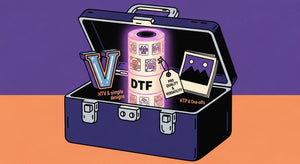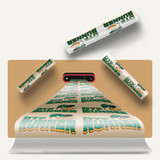Table of Contents
- Understanding DTF Transfers
- The Importance of Proper Storage for DTF Transfers
- Ideal Storage Conditions for DTF Transfers
- Best Practices for Handling DTF Transfers
- Preventing Moisture Damage to DTF Transfers
- Organizing DTF Transfers for Easy Access
- Preparing DTF Transfers for Use
- Managing Your DTF Transfers Inventory
- Educating Your Customers on DTF Transfers Care
- Conclusion: Maximizing the Longevity of Your DTF Transfers
This process is called direct-to-film and has been a massive success throughout the custom apparel industry making it excellent for custom apparels because of the high-quality print on different kinds of fabrics. But in order to maximize the efficiency of your DTF transfers proper storage and care are important. If you are a small business owner, an online custom printing hobbyist, or someone else who is using DTF transfers these tips will help preserve the quality of your transfers until the time comes for their use. The following post provides a detailed and complete guide that will help you find the ideal way to store and operate an DTF transfer while taking into accounts many factors like life maximization, quality standards and so on.

Understanding DTF Transfers
As a technology, DTF transfers are the new trend of applying custom designs on garments. This is done by printing a design on special film then transferring the image to the fabric using the heat press. One looks at DTF transfers for premium quality prints as they are made in vibrant colors and fine details and have high durability. Nonetheless, like any other print materials, DTF transfers need the proper care to stay great in a long time. Without proper storage or handling, transfers could fade, rip off, or become worthless blobs of color.
The Importance of Proper Storage for DTF Transfers
Why is storage such an important factor for DTF Transfers? The secret is in the materials and methods used to create them. DTF transfers are very prone to environmental factors such as heat, humidity and light. This can also affect the transfer film and make it warp, fall off color or decrease its adhesive properties. DTF transfers may even end up too challenging or impossible to utilise if stored improperly, meaning precious materials and possibly cash is wasted.
The correct storage methods will keep your DTF transfers in the same condition they were when they were produced. By keeping them stored in proper conditions they can last quite a bit longer and be used when you need. This not only saves time and money but also allows you to produce products of the highest quality.
Ideal Storage Conditions for DTF Transfers
One of the most important aspects in preserving quality DTF transfers is creating the right storage environment. DTF transfers should be stored in a cool and dry area not exposed to direct sunlight, as well as free from extreme temperature fluctuations. So here are some of the things to think about:
-
Temperature: DTF transfers should be kept at a room temperature, similar to 60-75°F (15-24°C). Warping of the film and adhesive breakdown can happen at extreme temperatures. Store transfers away from heat, such as radiators, stoves or direct sunlight, to prevent the temperature rise and material aging.
-
Humidity: Keep the humidity between 40%-60% to store DTF transfers. High moisture will be absorbed to the film, this may cause ambient tackiness, which makes it hard for screen-printing and other post processes. Too little will make the film brittle and it tends to have cracks. You may also want to use a dehumidifier in the storage area, or store your transfers in an airproof container with a silica gel packet.
-
Light Exposure: The colors in DTF transfers can fade if exposed to direct sunlight, especially the UV rays. To prevent this, keep store transfers away from light or use an opaque container. If your design allows it, you should not store your transfers, especially in an area where there are large windows or fluorescent lights because they also gives off UV-light.
Best Practices for Handling DTF Transfers
The next important thing after storing the DTF in the right place is handling the DTF transfers correctly so that there is no smudge, scratch or contamination of adhesive layer. Remember these best practices to ensure your DTF transfers go off without a hitch:
-
Wear Gloves: When handling DTF transfers, wear clean, lint-free gloves. This keeps oils, grime and dampness from your hands off the film. If no gloves are available, ensure your hands are clean and dry before setting transfers.
-
Handle by the Edges: Hold DTF transfers ONLY by the edges (not the print side or adhesive). Sticky fingerprints and stains on the canvas affect how well it can transfer images, resulting in poor adhesion or observable marks on the end product.
-
Use Protective Sheets: When stacking DTF transfers, use a protective sheet/parchment paper between each one. This way they don't glue themselves together, and the printed surface remains safe from scratches or any other type of harm.
Preventing Moisture Damage to DTF Transfers
One of the most hated enemies of DTF transfer is moisture, that's for sure. With exposure to moisture, it can become sticky and difficult to apply, or conversely cause the adhesive to lose its effectiveness. Prevent Moisture in your DTF Transfers with these Tips:
- Dark Spaces: Ensure that your DTF transfers are kept undercover and away from light to reduce the rate of oxidation during exposure.
- Airtight Containers: Store your DTF transfers in a tightly-sealed container to avoid moisture beading. Plastic bags work as well, the resealable variety is preferred as long you with a silica gel packet to take up any extra humidity.
- Dry Areas are Good: Do not store your DTF transfer in a basement, garage or anywhere which is suspected to be damp. Although they are contained in most airtight containers, continued exposure to the damp environment will inevitably lead to degradation of quality.
- Inspection: Occasionally make sure there is no condensation or musty smell or any moisture in the location where you store these. If you find any, transfer your DTF deposits elsewhere immediately.
Organizing DTF Transfers for Easy Access
Keeping your DTF transfers in order is important not only to prevent destruction but also to easily locate the designs you need. Here are some helpful organizational ideas:
-
Labels: Mark the design name, date and other pertinent information on each transfer or storage container. This way you can easily differentiate the correct transfer, without them all getting man-handled.
-
Storage Systems: Put it in a box, similar to how you would store important papers into a filing system. Protect each transfer by placing them in a sleeve/envelope and organize them by category, size, or customer order. It ensures that all your transfers lie flat and protected, but also helps to keep things organized on your end.
It is also a wise idea to use storage bins or drawers that are flat item friendly, stackable for greater space efficiency of your unit and easy access to the items inside.

Preparing DTF Transfers for Use
Preparing to apply your DTF transfers when the time comes is crucial to a good print. Review these steps before you begin:
- Examine External Condition: Inspect every transfer for signs of visible damage such as scuffs, scratches, discoloration or being brittle. If any of a transfer appears to have gone bad, do a test application on junk fabric before using it on your good stuff.
- Heat up Garment: Before you press on the DTF transfer, it's best to heat up the garment which will remove any moisture and get rid of folds, providing both better adhesion as well as making your finishing look more professional. Make sure to implement the right temperature for the recommendation of each fabric.
- Scrap Fabric Test: If you are not sure how well a transfer will work or you think your heat press settings might need to be adjusted, do a test on some scrap fabric. This lets you set temperature, pressure, and time, thus allowing you to experiment before creating the final garment.
Managing Your DTF Transfers Inventory
Maintaining accurate records of your DTF transfers inventory ensures smooth workflow and quality control. The following are some suggestions to employ while inputting inventory:
-
First in, first out (FIFO): Ensure that the older transfers are consumed before the newer ones by using the FIFO method. This will avoid keeping old transfers in store for too long and losing them quality-wise.
-
Inventory Log: Keep a record of the inventory, how it was designed, in what quantity and when it will be available. This enables you to see what you have and need to use it up by.
-
Frequent Audits: You should plan for regular stock audits to check for damaged or deteriorating goods, which can be identified and corrective action taken before they reach final products.
Educating Your Customers on DTF Transfers Care
If you are selling DTF transfers, giving your customers some care instructions will improve their usage experience and get the most out of your product. Some ways you can educate your customers include:
-
Instructions Cards: A brief simple little instruction card on how to store, handle and apply DTF transfers in each order.
-
Online Resources: Have a page only for DTF on your website/blog and write tips and FAQs for DTF Transfer Care. This can educate your customers and also establish your brand as a source of authority in the industry.
-
Customer Support: Offer support for inquiries or problems about DTF transfers. If you offer clear, informative guidance, customers will not only continue to buy from you but also recommend your company to their friends and family.
Conclusion: Maximizing the Longevity of Your DTF Transfers
Taking care of your DTF transfers, especially how you store and handle them is really important as it plays a role in quality maintenance, so if you have to use one at another day or time, it will likely perform at its best. Following these simple steps can help you preserve your investment in DTF transfers, save product and create custom wear that lasts. From warehousing them to save for future use to preparing them for short term application, these acts would help in not only using your DTF transfers effectively but also for a bit longer.
Follow these tips and you will get the brightest and most durable prints possible. Customers will never have to worry about quality; custom apparel screen printing is more than a sure business for you.






